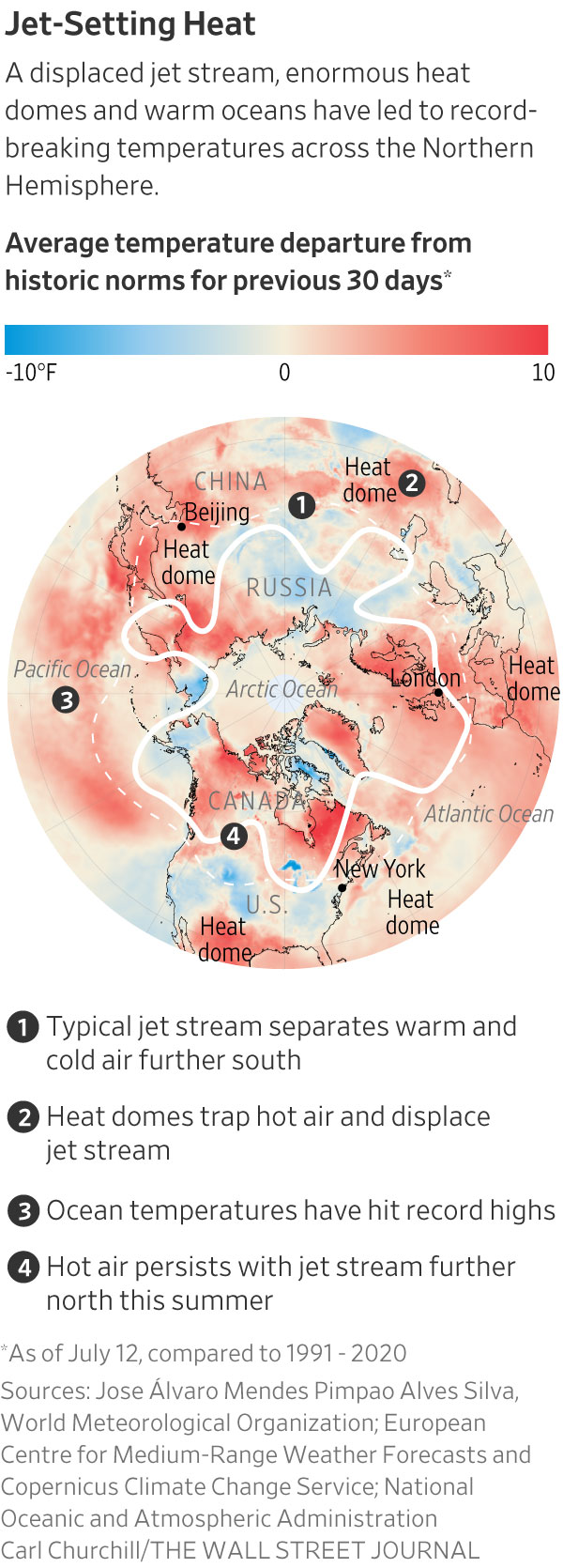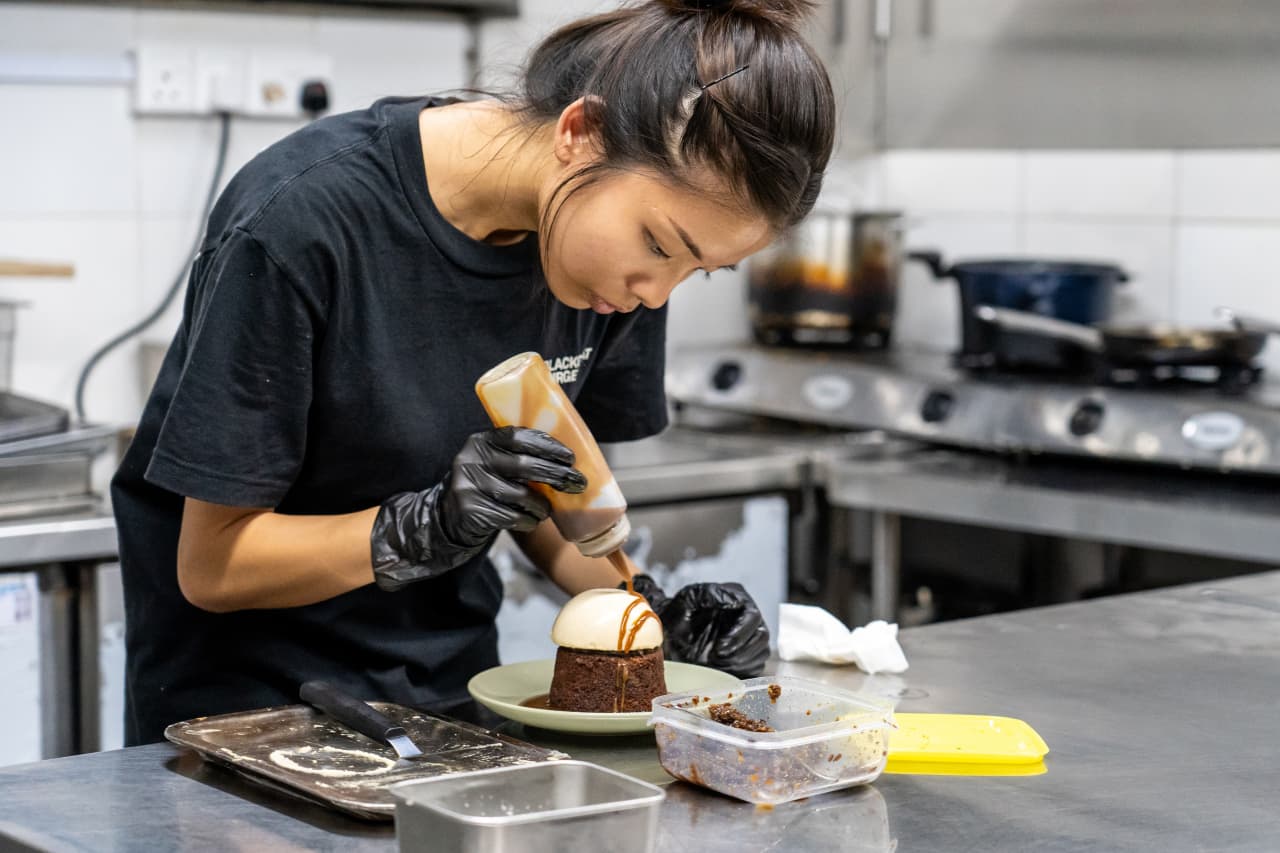The World Bakes Under Extreme Heat
Warming oceans and heat domes are contributing to one of the hottest summers on record
Deadly heat waves are upending daily life in large parts of the U.S., Europe and Asia, as warming oceans and unprecedented humidity fuel one of Earth’s hottest summers on record.
Meteorologists say last month was the hottest June on record and 2023 could be the hottest year ever if July’s record temperatures continue, straining businesses and threatening power grids.
Several factors are contributing to the record heat this summer, said Brett Anderson, a senior meteorologist at AccuWeather. Among them: Unusually warm oceans are raising humidity levels; several heat domes are trapping warmth around the world for longer than usual; and jet streams are causing deadly storms like the ones in Vermont this month to move slowly.
The hot seas and a recurring warm climate pattern called El Niño are compounding the effects of climate change, which scientists say is contributing to higher global temperatures.
“We are seeing an increasing number and more extremes and this is because of global warming,” said Jose Alvaro Mendes Pimpao Alves Silva, a consulting climatologist for the World Meteorological Organization, referring to extreme heat waves. “These situations are not unprecedented. But as they happen, their intensity is higher.”
Climate change has exacerbated extreme heat events, which have increased sixfold since the 1980s, according to the World Meteorological Organization. Increasing surface temperatures from climate warming make heat waves longer, more intense, and produce the weather conditions that keep them stalled over one place.
Global ocean temperatures hit record highs for the third consecutive month after El Niño conditions strengthened in June, according to the National Oceanic and Atmospheric Administration.
High-pressure heat domes that bring sweltering temperatures have occurred during the past few summers, but having four of them over land at the same time is still surprising to Carl Schreck, a tropical climatologist at North Carolina State University who works with NOAA.

“We’ve seen this over the last couple of summers, but it’s still remarkable when it does appear,” said Schreck.
Still, the sustained heat waves haven’t stopped tourists from hitting the beach in Spain or visiting landmarks in Washington, D.C. Some have even basked in the heat in California’s Death Valley, one of the hottest places on Earth.
U.S.
Several cities, including Phoenix, have broken records as the southern U.S. deals with unrelenting heat. El Paso, Texas, logged a record 33rd day in a row Tuesday with triple-digit temperatures. Texas’ power grids have held up despite concerns they couldn’t handle demand surges.
In the North, parts of Michigan, New York and Vermont have also broken daily temperature records this summer.
The waters off Florida in recent weeks have been hotter than 90 degrees, several degrees above normal, according to NOAA. The temperatures are threatening the coral reefs off the coast and fueling heat and humidity in the southern part of the state.
Europe
Europe is baking under a sustained heat wave that is covering much of the Mediterranean, according to the World Meteorological Organization. The Spanish state meteorological service warned of temperatures of between 108 and 111 degrees and issued alerts for the interior and Balearic Islands. Parts of the Balkans are also under alert.
The Italian island of Sardinia was forecast to approach an all-time high for the continent on Tuesday. Sicily set the highest recorded temperature in Europe at 119.8 degrees Fahrenheit, in August 2021.
Alberto Urpi, the mayor of Sanluri in Sardinia, said authorities had issued a weather red alert for the area, advising people to stay inside from late morning until 6 p.m.
“We are ready,” said Urpi. “We’ve gotten used to these heat waves and have had time to organise our response.”
Authorities closed the Acropolis in Athens for a large part of Friday and Saturday due to the heat. The Greek capital is forecast to stay above 97 degrees all week, topping out at almost 110 on Sunday.
Middle East
As temperatures soar to about 100 degrees across Egypt, the government has been cutting power in neighbourhoods across the country, forcing ordinary Egyptians to go without air conditioning, fans and refrigeration even during the hottest hours of the day.
“We are having horrible nights. Babies are crying because of the high temperatures and our refrigerator broke down,” said Nemaa Moustafa, a 31-year-old homemaker with newly born twins.
Egypt is in the midst of an economic crisis that has officials scrambling to bring in foreign currency to pay off staggering debts and stave off a currency collapse. Diverting the country’s natural-gas resources away from domestic use and toward lucrative exports is one way to get U.S. dollars.
In El-Shorouk city, on the outskirts of greater Cairo, residents said power cuts were happening four or five times a day, leaving them without electricity for hours. Some said they were also experiencing water disruptions making it more difficult to cope with the heat. Many stores and supermarkets have struggled to keep food fresh as refrigerators go down amid the cuts.
Asia
Another heat wave is simultaneously sweeping across parts of Asia. In China, a village in the northwestern region of Xinjiang hit a record high 126 degrees, according to state media.
During the heat wave, the U.S. climate envoy John Kerry met Chinese officials including Beijing’s top foreign policy envoy, Wang Yi, and Premier Li Qiang to discuss how to accelerate decarbonisation and other climate change goals. China and the U.S. are the world’s top greenhouse gas emitters.
Silva from the World Meteorological Organization said there are currently high-pressure systems trapping hot air in the region. The systems will remain in place over the next several days.
“It’s moving very slowly, but we will not have this situation forever,” Silva said.
—Chao Deng contributed to this article.
 Copyright 2020, Dow Jones & Company, Inc. All Rights Reserved Worldwide. LEARN MORE
Copyright 2020, Dow Jones & Company, Inc. All Rights Reserved Worldwide. LEARN MORE
This stylish family home combines a classic palette and finishes with a flexible floorplan
Just 55 minutes from Sydney, make this your creative getaway located in the majestic Hawkesbury region.
No trip to Singapore is complete without a meal (or 12) at its hawker centres, where stalls sell multicultural dishes from generations-old recipes. But rising costs and demographic change are threatening the beloved tradition.
In Singapore, it’s not unusual for total strangers to ask, “Have you eaten yet?” A greeting akin to “Good morning,” it invariably leads to follow-up questions. What did you eat? Where did you eat it? Was it good? Greeters reserve the right to judge your responses and offer advice, solicited or otherwise, on where you should eat next.
Locals will often joke that gastronomic opinions can make (and break) relationships and that eating is a national pastime. And why wouldn’t it be? In a nexus of colliding cultures—a place where Malays, Indians, Chinese and Europeans have brushed shoulders and shared meals for centuries—the mix of flavours coming out of kitchens in this country is enough to make you believe in world peace.
While Michelin stars spangle Singapore’s restaurant scene , to truly understand the city’s relationship with food, you have to venture to the hawker centres. A core aspect of daily life, hawker centres sprang up in numbers during the 1970s, built by authorities looking to sanitise and formalise the city’s street-food scene. Today, 121 government-run hawker centres feature food stalls that specialise in dishes from the country’s various ethnic groups. In one of the world’s most expensive cities, hawker dishes are shockingly cheap: A full meal can cost as little as $3.
Over the course of many visits to Singapore, I’ve fallen in love with these places—and with the scavenger hunts to find meals I’ll never forget: delicate bowls of laksa noodle soup, where brisk lashes of heat interrupt addictive swirls of umami; impossibly flaky roti prata dipped in curry; the beautiful simplicity of an immaculately roasted duck leg. In a futuristic and at times sterile city, hawker centres throw back to the past and offer a rare glimpse of something human in scale. To an outsider like me, sitting at a table amid the din of the lunch-hour rush can feel like glimpsing the city’s soul through all the concrete and glitz.
So I’ve been alarmed in recent years to hear about the supposed demise of hawker centres. Would-be hawkers have to bid for stalls from the government, and rents are climbing . An upwardly mobile generation doesn’t want to take over from their parents. On a recent trip to Singapore, I enlisted my brother, who lives there, and as we ate our way across the city, we searched for signs of life—and hopefully a peek into what the future holds.
At Amoy Street Food Centre, near the central business district, 32-year-old Kai Jin Thng has done the math. To turn a profit at his stall, Jin’s Noodle , he says, he has to churn out at least 150 $4 bowls of kolo mee , a Malaysian dish featuring savoury pork over a bed of springy noodles, in 120 minutes of lunch service. With his sister as sous-chef, he slings the bowls with frenetic focus.
Thng dropped out of school as a teenager to work in his father’s stall selling wonton mee , a staple noodle dish, and is quick to say no when I ask if he wants his daughter to take over the stall one day.
“The tradition is fading and I believe that in the next 10 or 15 years, it’s only going to get worse,” Thng said. “The new generation prefers to put on their tie and their white collar—nobody really wants to get their hands dirty.”
In 2020, the National Environment Agency , which oversees hawker centres, put the median age of hawkers at 60. When I did encounter younger people like Thng in the trade, I found they persevered out of stubbornness, a desire to innovate on a deep-seated tradition—or some combination of both.
Later that afternoon, looking for a momentary reprieve from Singapore’s crushing humidity, we ducked into Market Street Hawker Centre and bought juice made from fresh calamansi, a small citrus fruit.
Jamilah Beevi, 29, was working the shop with her father, who, at 64, has been a hawker since he was 12. “I originally stepped in out of filial duty,” she said. “But I find it to be really fulfilling work…I see it as a generational shop, so I don’t want to let that die.” When I asked her father when he’d retire, he confidently said he’d hang up his apron next year. “He’s been saying that for many years,” Beevi said, laughing.
More than one Singaporean told me that to truly appreciate what’s at stake in the hawker tradition’s threatened collapse, I’d need to leave the neighbourhoods where most tourists spend their time, and venture to the Heartland, the residential communities outside the central business district. There, hawker centres, often combined with markets, are strategically located near dense housing developments, where they cater to the 77% of Singaporeans who live in government-subsidised apartments.
We ate laksa from a stall at Ghim Moh Market and Food Centre, where families enjoyed their Sunday. At Redhill Food Centre, a similar chorus of chattering voices and clattering cutlery filled the space, as diners lined up for prawn noodles and chicken rice. Near our table, a couple hungrily unwrapped a package of durian, a coveted fruit banned from public transportation and some hotels for its strong aroma. It all seemed like business as usual.
Then we went to Blackgoat . Tucked in a corner of the Jalan Batu housing development, Blackgoat doesn’t look like an average hawker operation. An unusually large staff of six swirled around a stall where Fikri Amin Bin Rohaimi, 24, presided over a fiery grill and a seriously ambitious menu. A veteran of the three-Michelin-star Zén , Rohaimi started selling burgers from his apartment kitchen in 2019, before opening a hawker stall last year. We ordered everything on the menu and enjoyed a feast that would astound had it come out of a fully equipped restaurant kitchen; that it was all made in a 130-square-foot space seemed miraculous.
Mussels swam in a mushroom broth, spiked with Thai basil and chives. Huge, tender tiger prawns were grilled to perfection and smothered in toasted garlic and olive oil. Lamb was coated in a whisper of Sichuan peppercorns; Wagyu beef, in a homemade makrut-lime sauce. Then Ethel Yam, Blackgoat’s pastry chef prepared a date pudding with a mushroom semifreddo and a panna cotta drizzled in chamomile syrup. A group of elderly residents from the nearby towers watched, while sipping tiny glasses of Tiger beer.
Since opening his stall, Rohaimi told me, he’s seen his food referred to as “restaurant-level hawker food,” a categorisation he rejects, feeling it discounts what’s possible at a hawker centre. “If you eat hawker food, you know that it can often be much better than anything at a restaurant.”
He wants to open a restaurant eventually—or, leveraging his in-progress biomedical engineering degree, a food lab. But he sees the modern hawker centre not just as a steppingstone, but a place to experiment. “Because you only have to manage so many things, unlike at a restaurant, a hawker stall right now gives us a kind of limitlessness to try new things,” he said.
Using high-grade Australian beef and employing a whole staff, Rohaimi must charge more than typical hawker stalls, though his food, around $12 per 100 grams of steak, still costs far less than high-end restaurant fare. He’s found that people will pay for quality, he says, even if he first has to convince them to try the food.
At Yishun Park Hawker Centre (now temporarily closed for renovations), Nurl Asyraffie, 33, has encountered a similar dynamic since he started Kerabu by Arang , a stall specialising in “modern Malay food.” The day we came, he was selling ayam percik , a grilled chicken leg smothered in a bewitching turmeric-based marinade. As we ate, a hawker from another stall came over to inquire how much we’d paid. When we said around $10 a plate, she looked skeptical: “At least it’s a lot of food.”
Asyraffie, who opened the stall after a spell in private dining and at big-name restaurants in the region, says he’s used to dubious reactions. “I think the way you get people’s trust is you need to deliver,” he said. “Singapore is a melting pot; we’re used to trying new things, and we will pay for food we think is worth it.” He says a lot of the same older “uncles” who gawked at his prices, are now regulars. “New hawkers like me can fill a gap in the market, slightly higher than your chicken rice, but lower than a restaurant.”
But economics is only half the battle for a new generation of hawkers, says Seng Wun Song, a 64-year-old, semiretired economist who delves into the inner workings of Singapore’s food-and-beverage industry as a hobby. He thinks locals and tourists who come to hawker centers to look for “authentic” Singaporean food need to rethink what that amorphous catchall word really means. What people consider “heritage food,” he explains, is a mix of Malay, Chinese, Indian and European dishes that emerged from the country’s founding. “But Singapore is a trading hub where people come and go, and heritage moves and changes. Hawker food isn’t dying; it’s evolving so that it doesn’t die.”
This stylish family home combines a classic palette and finishes with a flexible floorplan
Just 55 minutes from Sydney, make this your creative getaway located in the majestic Hawkesbury region.






















